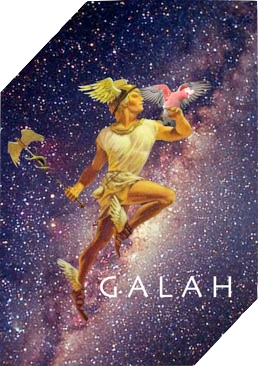Instrumentation and observing
HERMES
GALAH observes using the HERMES spectrograph (Sheinis et al. 2015) at the Anglo-Australian Telescope. HERMES is a four-channel, multiobject, R~28,000 spectrograph fed by the 2dF fibre positioner (Lewis et al. 2002), which sits at prime focus. 2dF has two field plates, each of which has 392 science fibres and 8 guide bundles that can be allocated across a circular field with a two-degree diameter. One field plate can be set up by the fibre positioning robot while the other plate is being used for observation. Fibres subtend 2.1 arcseconds on the sky, with a positioning accuracy of 0.3 arcseconds, and have a minimum separation of about 30 arcseconds.
The fibres from the two 2dF plates are arranged in two pseudoslits that can move into place to inject light into the spectrograph. HERMES uses an off-axis collimator mirror, a series of dichroic elements, and volume phase holographic gratings to capture the wavelength regions 4715–4900 Å, 5649–5873 Å, 6478–6737 Å, and 7585–7887 Å in four cameras with independent shutters. The spectra are dispersed in the horizontal direction in the raw data, with one spectrum trace for each fibre.
HERMES spectra have a signal-to-noise ratio of 100 per resolution element in one hour of exposure time for stars with an apparent magnitude of 14 in the relevant Johnson/Cousins filter (B for the blue camera, V for the green camera, R for the red camera and I for the IR camera). The blue and green cameras use 16 micron, standard silicon detectors; the red camera has a 40 micron, deep depletion device with fringe suppression and an ER1 coating; and the IR camera has a 100-micron bulk silicon device with fringe suppression and a "Multi-9" coating. Further details on 2dF and HERMES can be found in the user manual.
Observing
Targets for the main GALAH survey are selected to fall in one of three magnitude ranges: 9<V<12 (bright fields), 12<V<14 (regular fields), or 12<V<14.3 (faint fields). For observability from Siding Spring Observatory, declination is restricted to −80<dec<+10, and to avoid target confusion and excessive extinction, Galactic latitude is restricted to |b|>10.
These targets are tiled into 6545 fields on the sky, with a field radius that varies with target density and a minimum density of 400 stars per field. Fields containing more than 400 stars are subdivided into multiple 400-star configurations. Observers use software developed within the team to choose configurations to observe, ensuring that the field centre will be within 1.5 hours of the meridian through the whole observation.
The coordinates and proper motions for the targets in each configuration are input into the Configure program, along with a set of 20 candidate fiducial stars for guiding. The fiducial stars are taken from the GALAH target catalogue in the same field of view, with magnitudes in the range 11 < V < 12. Configure finds an optimal arrangement for the science targets and fiducial stars using a simulated annealing algorithm and outputs a file that is passed to the fibre positioning robot to set up the field. Further details on Configure can be found in Miszalski et al. 2006.
The standard exposure time for a configuration is one hour, taken as three 20-minute exposures. This is extended to four exposures if the seeing is between 2 and 2.5 arcseconds, and to six exposures if the seeing is between 2.5 and 3 arcseconds. Flat-field and arc exposures are taken directly before or after each science configuration, since moving between the two pseudoslits moves the position of the spectrum traces on the detector slightly.
